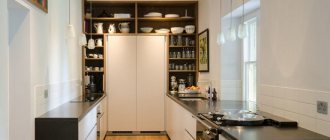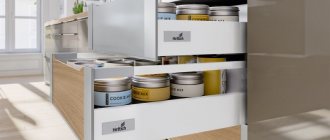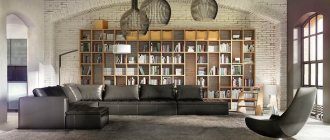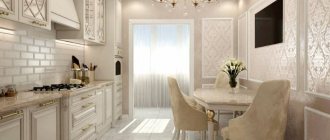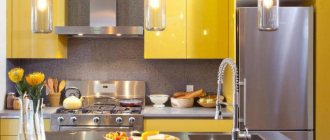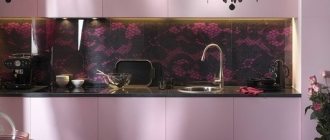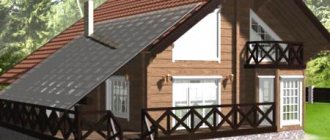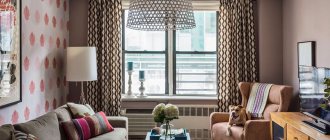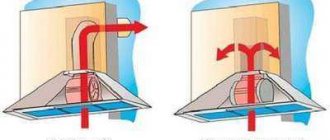The kitchen apron is considered one of the most important and noticeable interior details of this room. The finishing features and color scheme of the part of the wall between the countertop and wall cabinets often become almost key in the overall design solution of the kitchen. Experts advise approaching the issue of choosing a color for a kitchen apron no less carefully than choosing the material for its design.
Photo:
Gray apron in wenge kitchen with white
Main selection criteria
Many people choose an apron for the kitchen only based on external features - whether it corresponds to modern trends, whether it matches the kitchen set, whether they like it or not. However, it is more correct to start considering the types of aprons from the materials from which they are made. The color and shape can be selected later. Fortunately, today technologies make it possible to apply all kinds of prints, photo printing, gold plating, imitate stone, play with colors, etc. on almost any material.
The main criteria for choosing an apron for the kitchen are wear resistance and ease of maintenance. It is more practical to choose a material with the following characteristics:
- smooth, without any depressions in which dirt can accumulate;
- shockproof;
- moisture resistant, non-porous;
- resistant to temperature changes;
- easy to clean, resistant to cleaning agents (does not scratch, does not fade).
In addition, a high-quality apron should have a minimum of joints. It's even better if it's made from a solid slab. If tiles are selected, moisture-resistant grout must be used. To seal the seams, special borders are used, which are placed on moisture-resistant silicone or sealant.
Which apron to choose for a small kitchen?
When considering different options for kitchen aprons, there are some points to consider when choosing an apron for a small kitchen.
Considering that in a small kitchen space is limited, to visually expand it it is necessary to use light colors, where a light set will give a complete picture with a light apron.
Mirror surfaces will also help to visually expand the space. However, it should be remembered here that the presence of small objects reflected in the mirror surface can create a feeling of clutter.
You should not arrange an apron with large drawings, patterns and photo printing in a small space. Such elements will weigh down the design of the room. At the same time, a small, unobtrusive pattern will be harmonious. An apron containing horizontal stripes in the pattern will visually lengthen the room.
Also, designers do not recommend using bright apron colors. In a small space they will “pressure” and worsen a person’s mental state.
A combination of two contrasting colors (for example, white and black) is not acceptable for a small space. This combination will visually reduce the kitchen space and make it cluttered.
To make the kitchen stylish and interesting, you need to carefully think through its design and select finishing materials.
The design of the kitchen apron plays a special role in this room.
It should be combined with the overall interior in terms of color, size, and materials.
Top 5 types of aprons
The most popular today are kitchen aprons made of glass (skinali), artificial stone, plastic and MDF. Also, the classic – ceramic tiles – never goes out of style. All types are good in their own way. To understand which one best suits personal preferences and financial capabilities, we suggest studying the comparative characteristics.
Glass
The kitchen apron is made of tempered glass - it is very durable and easy to clean. With its help you can implement almost any design solution. For example, using transparent glass, emphasize the beauty of wall decoration, or place decorative film with photo printing, dried flowers, or children's drawings between two glasses. For finishing you can choose frosted glass, textured, colored and even mirrored. There are plenty of options.
Advantages of a glass apron:
- has an aesthetic appearance;
- many design variations;
- hygienic;
- durable,
- lasting;
- heat resistant.
We recommend: How to choose the right LED lamps for apartment lighting
Flaws:
- easily soiled;
- expensive;
- relatively fragile.
MDF apron
A budget option, but at the same time quite practical. An MDF (medium density fibreboard) backsplash is often included with kitchen units. You can also choose it separately; the product is quickly manufactured and easy to install. There are also many color variations: stone finishes, mosaics, tiles, drawings, photo printing, etc.
Advantages of MDF apron for the kitchen:
- low price;
- easy installation and dismantling;
- quite moisture resistant and durable;
- hygienic;
- universal, suitable for almost any stylistic solution.
The main disadvantage of such an apron is its low heat resistance. If a gas stove is placed nearby, in the event of a fire, the fire will spread quickly. The second disadvantage of the material is its tendency to deform. It cannot be called durable; its service life ranges from 5 to 10 years.
Ceramic tile
The tiled apron is a leader in practicality and price/quality ratio. Many will call this option old-fashioned - and they will be wrong. Today there are so many types of tiles that they can satisfy the most demanding taste: mosaic, textured, voluminous, with a metal coating, intricate patterns, embossing (for example, leather), large and small, combined sizes. The list can be endless. Let’s move on to the advantages of a ceramic tile backsplash:
- hygienic – does not stain, is easy to clean, does not absorb moisture and fat;
- heat-resistant – does not burn, does not melt;
- diverse - with it you can bring to life a lot of decor ideas;
- durable - does not scratch, does not leave dents;
- durable – service life from 15 to 50 years;
- completely safe - does not accumulate static electricity, does not conduct current.
There are few disadvantages to tiles:
- complexity of dismantling and installation;
- the need to level the wall before work;
- the presence of seams between the tiles, which reduce hygiene and require additional care.
Plastic
The characteristics of a plastic apron are comparable to those of MDF. It often comes complete with furniture, comes in a variety of shapes and shades, and is easy to install. There are several types: carbonate glass, PVC panels, vinyl, lining and laminate. But if the first two materials are considered relatively durable, hygienic and safe, then using the rest for installation next to the hob is simply reckless. Not only can they burst into flames instantly, but they are also easily deformed by temperature changes, and when heated, they release toxic substances into the air.
Apron made of liquid artificial stone
One of the most expensive aprons for the kitchen. Its undoubted advantages are the ability to create a single composition with the countertop and sink and easy restoration. Scratches or other defects are eliminated with the same putty from which the apron is made. It is made from acrylic or quartz agglomerate. The first is essentially plastic, is flammable and easily deteriorates. But quartz agglomerate really deserves attention. He is afraid of only one thing - bleach (loses color).
We recommend: Taste of summer instead of “plastic” from the greenhouse: how to choose delicious tomatoes?
Advantages:
- hygienic;
- lasting;
- durable;
- “expensive” in appearance;
- heat resistant;
- easy to restore;
- can be connected to the tabletop without a seam.
Flaws:
- high price;
- installed only by specialists;
- limited choice of colors.
Most suitable sizes
The average height of the apron is about half a meter, but the optimal dimensions still depend on some factors: the height of the person and the type of stove.
When creating the required apron option, it is recommended to adhere to several important details:
- the dimensions should be slightly larger than the final version so that the outer parts can extend a few centimeters behind the pieces of furniture;
- It is recommended to treat the connection between the apron and the tabletop with silicone sealant to prevent further penetration of moisture and deformation of the material;
- the surface should be as smooth and even as possible.
To minimize the cost of funds, it is better to purchase a budget version of the set, wallpaper, flooring, which is shown in the photo of the kitchen apron, but in no case save on the apron.
In this case, it is important to determine the leading role and design of the apron. The most traditional color is white in combination with color inserts or photo printing. If you use a bright option, then it, undoubtedly, should be supported by similar details in the overall interior.
Luxury and unusual aprons for the kitchen
Aprons made from the above materials are universal; you can use them to create any design in the kitchen. But for some this is not enough.
If you want something unusual, even at the expense of practicality, you should choose one of the following options:
- marble;
- from natural stone;
- made of natural wood;
- stainless steel;
- from pebbles;
- from a cut of brick;
- in the form of a board covered with slate paint.
Metal apron
If the kitchen is designed in a high-tech style, an apron made of metal tiles or a smooth stainless steel sheet, which can be decorated with decorative elements, will fit into it.
Metal apron in the kitchen photo
Among the advantages of a metal apron are resistance to moisture, sudden changes in temperature, and fire. Its price is quite affordable and depends on the complexity of the decorative elements.
Metal apron in the kitchen photo
It also has disadvantages:
- Difficulty of using any style other than high-tech in the interior;
- Any stains and smudges are very noticeable, which requires constant care of the surface.
Metal apron in the kitchen photo
Types of kitchen aprons
An “apron” for the kitchen is a kind of shield installed between the work area and up to the level of the upper shelves. Its role is to protect the wall surface from grease, various stains, soot, steam and other emissions inherent in the cooking process. In addition to this function, it also has decorative qualities, transforming the kitchen design and giving it new, bright colors.
The main feature of such “aprons” is that they are made from a variety of different materials, which allows each housewife to choose a model to suit her taste and color, and at the best price. It is worth noting 5 types of this protective coating that are in greatest demand: plastic, glass, “aprons” made of MDF and tiles, as well as models with unique photo prints.
Plastic
Plastic has the optimal balance of cost, practicality and quality. In the production of plastic aprons, polyvinyl chloride (PVC) panels are used.
The main advantages of which are:
- resistance to pollution and durability;
- strength;
- ease of installation;
- aesthetic appearance.
Advantages and disadvantages
- This apron is resistant to hot steam and moisture.
- An indisputable advantage is the relative cheapness compared to other analogues, for example, made of stone or tile.
- However, it should be borne in mind that when cleaning the work surface, you should avoid using abrasive materials, as this can lead to scratches and will significantly spoil the overall favorable impression of the kitchen.
- It is also necessary to protect the panels from exposure to open fire, as this will lead to their irreversible deformation.
Cleaning and maintenance
- When choosing an apron, you should choose a solid sheet of plastic without seams, because dirt and grease accumulated in the seams are difficult to remove during cleaning and worsen the appearance.
- To maintain and clean a plastic apron, no special detergents are required, since a regular soap solution and a damp sponge will do, and the ease of maintenance can significantly save time when cleaning.
Material safety
- When choosing panels, you should pay attention to the environmental safety of the raw materials, because in the manufacture of a high-quality apron the same polyvinyl chloride should be used as is used in the manufacture of utensils intended for storing food products.
- If this requirement is met, you do not have to worry about the health and well-being of your household.
A plastic kitchen apron has a number of undeniable advantages over analogues made from other materials, however, when making the final decision, in any case, you will have to be guided only by your taste, preferences and financial capabilities.
Skinali - kitchen “apron” made of glass
Recently, this type of protective covering for the kitchen work area has become very popular, as it has a number of its own advantageous qualities and brings some novelty to the design of any room, making it brighter and more spacious.
Based on the type of glass processing, skinals can be divided into several categories, namely:
- Matte. This type of glass is known to everyone due to its muted tone and shine, making it more attractive than the standard type. Overall, the material is durable and completely environmentally friendly, can withstand high temperatures and can be easily cleaned with glass cleaner. However, the matte finish does not hide marks from stains or dust, and is also easily scratched.
- Painted model. It is worth noting that plain colored “aprons” look quite impressive, organically complementing any style, and thanks to heat treatment, the paint itself is able to retain its properties for a long time and is not prone to shedding.
- Glass with an image on vinyl film. This option can be called budget, as it serves as an alternative replacement for photo printing. The basic principle is that the film is glued to the inside of the model, thereby protecting the pattern from high humidity, fire and stains. It is important to consider that such a coating may wrinkle, peel off or lose its brightness over time.
- Triplex is a kitchen “apron” made of tempered laminated glass. This type has a multi-layer texture that reliably protects the image from any negative factors, however, due to its dimensions it is very expensive, and due to its thickness, problems may arise with cutting holes in the material itself.

